House of Wisdom
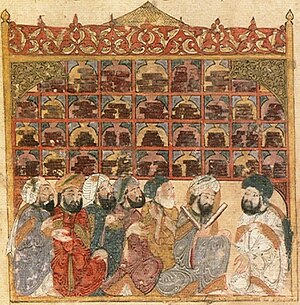
The House of Wisdom (Template:Lang-ar; Bayt al-Hikma) was a major intellectual center during the Islamic Golden Age. The House of Wisdom was founded by Caliph Harun al-Rashid (reigned 786–809) and culminated under his son al-Ma'mun (reigned 813–833) who is credited with its formal institution. Al-Ma'mun is also credited with bringing many well-known scholars to share information, ideas, and culture in the House of Wisdom. Based in Baghdad from the 9th to 13th centuries, many learned scholars including those of Jewish or Christian background[1] were part of this research and educational institute. Besides translating books into Arabic and preserving them, scholars associated with the House of Wisdom also made many remarkable original contributions to diverse fields.[2][3]
During the reign of al-Ma'mun, astronomical observatories were set up, and the House was an unrivaled center for the study of humanities and for science in medieval Islam, including mathematics, astronomy, medicine, alchemy and chemistry, zoology, and geography and cartography. Drawing on Greek, Indian and Persian texts, the scholars accumulated a great collection of world knowledge, and built on it through their own discoveries. By the middle of the ninth century, the House of Wisdom had the largest selection of books in the world.[3]
It was destroyed in the sack of the city following the Mongol Siege of Baghdad (1258).
History
Foundation and origins
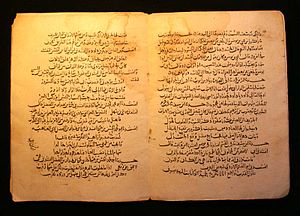
The preservation and development of human knowledge was a cherished tradition of the Eastern Christianity.[4] Throughout the 4th to 7th centuries, scholarly work in the Greek and Syriac languages was either newly initiated, or carried on from the Hellenistic period. Centers of learning and of transmission of classical wisdom included colleges such as the School of Nisibis and later the School of Edessa, and the renowned hospital and medical academy of Jundishapur; libraries included the Library of Alexandria and the Imperial Library of Constantinople; and other centers of translation and learning functioned at Merv, Salonika, Nishapur and Ctesiphon situated just south of what was later to become Baghdad.[5][6]
Through the Umayyad era, founded by Caliph Muawiyah I, during the reign of Caliph Al-Ma'mun, he starts to gather a collection of books in Damascus. He then formed a library that were referred by the name of "Bayt al-Hikma".[3] Books written in Greek, Latin, and Persian in the fields of medicine, alchemy, physics, mathematics, astrology and other disciplines were also collected and translated by Muslim scholars at that time.[7] Remarkably, the Umayyads also appropriated paper-making techniques from the Chinese and joined many ancient intellectual centers under their rule, and employed Christian and Persian scholars to both translate works into Arabic, and to develop new knowledge.[8] These were fundamental elements that contributed directly to the flourishing of scholarship in the Arab world.[7]
In 750, the Abbasid dynasty replaced the Umayyad as the ruling dynasty of the Islamic Empire, and, in 762, the caliph al-Mansur (r. 754 – 775) built Baghdad and made it his capital, instead of the old Damascus. Baghdad's location and cosmopolitan population made the perfect location for a stable commercial and intellectual center.[7] The Abbasid dynasty had a strong Persian bent,[9] and adopted many practices from the Sassanian Empire – among those, that of translating foreign works, except that now texts were translated into Arabic. For this purpose, al-Mansur founded a palace library, modeled after the Sassanian Imperial Library, and provided economic and political support to the intellectuals working there. He also invited delegations of scholars from India and other places to share their knowledge of mathematics and astronomy with the young Abbasid court.[7]
In the Abbasid Empire, many foreign works were translated into Arabic from Greek, Chinese, Sanskrit, Persian and Syriac. The Translation Movement gained great momentum during the reign of caliph al-Rashid, who, like his predecessor, was personally interested in scholarship and poetry.[3] Originally the texts concerned mainly medicine, mathematics and astronomy; but, other disciplines, especially philosophy, soon followed. Al-Rashid's library, direct predecessor to the House of Wisdom, was also known as Bayt al-Hikma or, as the historian Al-Qifti called it, Khizanat Kutub al-Hikma (Arabic for "Storehouse of the Books of Wisdom").[3]
Under Al-Ma'mun

Under the sponsorship of caliph al-Ma'mun (r. 813 – 833), economic support of the House of Wisdom and scholarship in general was greatly increased. Moreover, Abbasid society itself came to understand and appreciate the value of knowledge, and support also came from merchants and the military.[7] It was easy for scholars and translators to make a living and an academic life was a symbol of status.[3] Wisdom was so valuable that books and ancient texts were sometimes preferred as war booty instead of other riches.[3] Indeed, Ptolemy's Almagest was claimed as a condition for peace after a war between the Abbasids and the Byzantine Empire.[10]
The House of Wisdom was much more than an academic center removed from the broader society. Its experts served several functions in Baghdad. Scholars from the Bayt al-Hikma usually doubled as engineers and architects in major construction projects. They kept accurate official calendars and were public servants. They were also frequently medics and consultants.[3][7]
Al-Ma'mun was personally involved in the daily life of the House of Wisdom, regularly visiting its scholars and inquiring about their activities. He would also participate in and arbitrate academic debates.[7] Furthermore, he would often organize groups of sages from the Bayt al-Hikma into major research projects to satisfy his own intellectual needs. For example, he commissioned the mapping of the world, the confirmation of data from the Almagest and the deduction of the real size of the Earth (see section on the main activities of the House). He also promoted Egyptology and participated himself in excavations of the pyramids of Giza.[3]
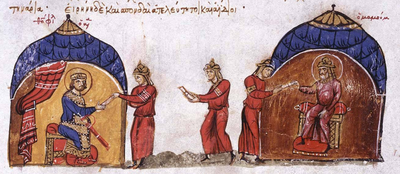
Following his predecessors, al-Ma'mun would send expeditions of scholars from the House of Wisdom to collect texts from foreign lands. In fact, one of the directors of the House was sent to Constantinople with this purpose. During this time, Sahl ibn Harun, a Persian poet and astrologer, was the chief librarian of the Bayt al-Hikma. Hunayn ibn Ishaq (809–873) an Assyrian Nestorian Christian physician and scientist, was the most productive translator producing 116 works for the Arabs. As "Sheikh of the translators" he was placed in charge of the translation work by the caliph. The Sabian Thābit ibn Qurra (826–901) also translated great works by Apollonius, Archimedes, Euclid and Ptolemy. Translations of this era were superior to earlier ones, since the new Abbasid scientific tradition required better and better translations, and the emphasis was many times put in incorporating new ideas to the ancient works being translated.[7]
By the second half of the ninth century al-Ma'mun's Bayt al-Hikma was the greatest repository of books in the world and had become one of the greatest hubs of intellectual activity in the Middle Ages, attracting the most brilliant Arab and Persian minds.[3] The House of Wisdom eventually acquired a reputation as a center of learning, although universities as we know them did not yet exist at this time — knowledge was transmitted directly from teacher to student, without any institutional surrounding. Maktabs soon began to develop in the city from the 9th century on, and in the 11th century, Nizam al-Mulk founded the Al-Nizamiyya of Baghdad, one of the first institutions of higher education in Iraq.
Decline under Al-Mutawakkil
The House of Wisdom flourished under al-Ma'mun's successors al-Mu'tasim (r. 833–842) and his son al-Wathiq (r. 842 – 847), but considerably declined under the reign of al-Mutawakkil (r. 847–861).[11] Although al Ma'mun, al Mu'tasim, and al Wathiq followed the sect of Mu'tazili, which supported mind-broadness and scientific inquiry, al-Mutawakkil endorsed a more literal interpretation of the Qur'an and Hadith.[11] The caliph was not interested in science and moved away from rationalism, seeing the spread of Greek philosophy as anti-Islamic.[11]
Destruction by the Mongols
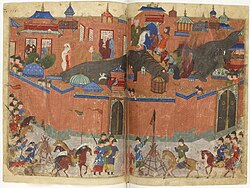
The Mongol siege of 1258 AD began in mid-January and lasted just two weeks. On February 13, the Mongols entered the city of the caliphs, commencing a full week of pillage and destruction. Along with all other libraries in Baghdad, the House of Wisdom was destroyed by the army of Hulagu during the Siege of Baghdad.[12] The books from Baghdad’s libraries were thrown into the Tigris River in such quantities that the river ran black with the ink from the books.[13] Nasir al-Din al-Tusi rescued about 400,000 manuscripts which he took to Maragheh before the siege.[14]
Although the Mongol invasion is usually considered the sole cause of the sharp end of Arab science, by the second half of the 13th century Baghdad was far from being the only academic center in the Abbasid Empire, so the destruction of the House of Wisdom was not the sole cause of the decay of Arab scholarship.[12]
Main activities
The House of Wisdom included a society of scientists and academics, a translation department and a library that preserved the knowledge acquired by the Abbasids over the centuries.[7] Furthermore, linked to it were also astronomical observatories and other major experimental endeavors.[3] Indeed, the House of Wisdom was much more than a library, and a considerable amount of original scientific and philosophical work was produced by scholars and intellectuals related to it.[3]
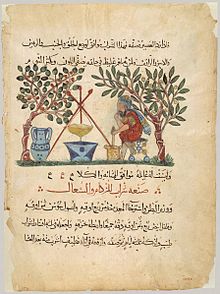
Translation
Over a century and a half, primarily Christian scholars translated all scientific and philosophic Greek texts available to them.[15][16] The translation movement at the House of Wisdom was inaugurated with the translation of Aristotle's Topics. By the time of al-Ma'mun, translators had moved beyond Greek astrological texts, and Greek works were already in their third translations.[3] Authors translated include: Pythagoras, Plato, Aristotle, Hippocrates, Euclid, Plotinus, Galen, Sushruta, Charaka, Aryabhata and Brahmagupta.
Furthermore, new discoveries motivated revised translations and commentary correcting or adding to the work of ancient authors.[7] In many cases names and terminology were changed; a prime example of this is the title of Ptolemy's Almagest, which is an Arabic modification of the original name of the work: Megale Syntaxis.[7]
Original contributions
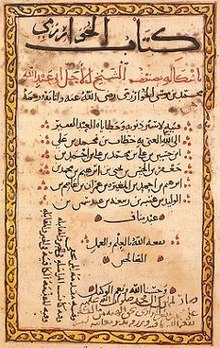

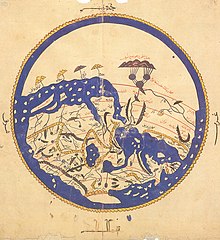
Besides translation and commentary of earlier works, scholars at the Bayt al-Hikma produced important original research. For example, famous mathematician al-Khwarizmi worked in al-Ma'mun's House of Wisdom and is famous for his contributions to the development of algebra.[3] He is also known for his book Kitab al-Jabr in which he develops a number of algorithms.[3] The application of the word "algebra" to mathematics and the etymology of the word "algorithm" can be traced back to al-Khwarizmi — the actual concept of an algorithm dates back before the time of Euclid. Besides that, this mathematician is responsible for the introduction of the Hindu decimal system to the Arab world, and through them to Europe. There were also important breakthroughs in cryptanalysis by Al-Kindi.[3]
There were also many original contributions to astronomy and physics. Mohammad Musa might have been the first person in history to point to the universality of the laws of physics.[3] In the 10th century, Ibn al-Haytham (Alhazen) performed several physical experiments, mainly in optics, achievements still celebrated today.[17]
Mohammad Musa and his brothers Ahmad and Hasan (collectively known as the "Banu Musa brothers") were also remarkable engineers. They are authors of the renowned Book of Ingenious Devices, which describes about one hundred devices and how to use them. Among these was "The Instrument that Plays by Itself", the earliest example of a programmable machine.[18]
In medicine, Hunayn wrote an important treatise on ophthalmology. Other scholars also wrote on smallpox, infections and surgery. Note that these works, would later become standard textbooks of medicine in the Renaissance.[19]
Under al-Mamun lead science saw for the first time bigger research projects involving large groups of scholars.[20] In order to check Ptolemy's observations, the caliph ordered the construction of the first astronomical observatory in Baghdad (see Observatories section below). The data provided by Ptolemy was meticulously checked and revised by a highly capable group of geographers, mathematicians and astronomers.[7] Al-Mamun also organized research on the circumference of the Earth and commissioned a geographic project that would result in one of the most detailed world-maps of the time.[20] Some consider these efforts the first examples of large state-funded research projects.[20]
Observatories
The creation of the first observatory in the Islamic world was ordered by caliph al-Mamun in 828. The construction was directed by scholars from the House of Wisdom: senior astronomer Yahya ibn abi Mansur and the younger Sanad ibn Ali al-AlYahudi.[21] It was located in al-Shammasiyya and was called Maumtahan Observatory. After the first round of observations of Sun, Moon and the planets, a second observatory on Mount Qasioun, near Damascus, was constructed. The results of this endeavor were compiled in a work known as al-Zij al-Mumtahan, which translates as "The Verified Tables".[20][22]
People
This is a list of notable people related to the House of Wisdom, most of them are mentioned in the text above. Besides the listed occupation, most of them were also translators:
- Sahl ibn Harun (d. 830), chief librarian;
- Hunayn ibn Ishaq (809-873), physician (Arab Christian);
- Yaqub ibn Ishaq al-Kindi (801-873), philosopher and polymath;
- Muhammad ibn Mūsā al-Khwārizmī (780–850), mathematician;
- The Banu Musa brothers, engineers and mathematicians;
- Sind ibn Ali (d. 864), astronomer;
- Abu Uthman, usually known as Al-Jahiz (781-861), writer and biologist;
- Al-Jazari (1136–1206), physicist and engineer.
Other houses of wisdom
Some other places have also been called House of Wisdom, and should not be confused with Baghdad's Bayt al-Hikma:
- In Cairo, Dar al-Hikmah, the "House of Wisdom", was another name of the House of Knowledge, founded by the Fatimid Caliph Al-Hakim bi-Amr Allah in 1004.[3]
- There is a research institute in Baghdad called Bayt al-Hikma after the Abbasid-era research center. While the complex includes a 13th-century madrasa, it is not the same building as the medieval Bayt al-Hikma. It was damaged during the 2003 invasion of Iraq33°20′32″N 44°23′01″E / 33.3423°N 44.3836°E
- The main library at Hamdard University in Karachi, Pakistan is called 'Bait al Hikmah'.
- La Maison de la Sagesse préselectionnée pour le Prix International au Maroc : http://www.lemauricien.com/article/prix-international-memoire-la-democratie-et-la-paix-2016-la-maison-la-sagesse-preselectionne
See also
- Round city of Baghdad
- Brethren of Purity
- Dar Al-Hekma
- Dar Al-Hekma College
- Astronomy in medieval Islam
Notes and citations
- ^ Hyman and Walsh Philosophy in the Middle Ages Indianapolis, 1973, p. 204' Meri, Josef W. and Jere L. Bacharach, Editors, Medieval Islamic Civilization Vol.1, A-K, Index, 2006, p. 304.
- ^ Meri, p. 451.
- ^ a b c d e f g h i j k l m n o p q r Al-Khalili, pp. 67-78
- ^ Ferguson, Kitty Pythagoras: His Lives and the Legacy of a Rational Universe Walker Publishing Company, New York, 2008, (page number not available – occurs toward end of Chapter 13, “The Wrap-up of Antiquity”). “It was in the Near and Middle East and North Africa that the old traditions of teaching and learning continued, and where Muslim scholars were carefully preserving ancient texts and knowledge of the ancient Greek language.”
- ^ Kaser, Karl The Balkans and the Near East: Introduction to a Shared History p. 135.
- ^ Yazberdiyev, Dr. Almaz Libraries of Ancient Merv Dr. Yazberdiyev is Director of the Library of the Academy of Sciences of Turkmenistan, Ashgabat.
- ^ a b c d e f g h i j k l Lyons, pp. 55-77
- ^ Meri, Josef W. and Jere L. Bacharach. “Medieval Islamic Civilization”. Vol. 1 Index A – K. 2006, p. 304.
- ^ Wiet. Baghdad
- ^ Angelo, Joseph (2009). Encyclopedia of Space and Astronomy. p. 78. ISBN 9781438110189.
- ^ a b c Al-Khalili, p. 135
- ^ a b Al-Khalili, p. 233
- ^ "The Mongol Invasion and the Destruction of Baghdad". Lost Islamic History.
- ^ Saliba, p.243
- ^ Rosenthal, Franz The Classical Heritage in Islam The University of California Press, Berkely and Los Angeles, 1975, p. 6
- ^ Adamson, London Peter The Great Medieval Thinkers: Al-Kindi Oxford University Press, New York, 2007, p. 6. London Peter Adamson is a Lecturer in Late Ancient Philosophy at King's College.
- ^ Al-Khalili, pp. 152–171
- ^ Koetsier
- ^ Moore
- ^ a b c d Al-Khalili, pp. 79-92
- ^ Hockey 1249
- ^ Zaimeche, p. 2
References
- Al-Khalili, Jim (2011), The House of Wisdom: How Arabic Science Saved Ancient Knowledge and Gave Us the Renaissance, New York: Penguin Press, ISBN 9781594202797
- Lyons, Jonathan (2009), The House of Wisdom: How the Arabs Transformed Western Civilization, New York: Bloomsbury Press, ISBN 9781596914599
- Meri, Joseph; Bacharach, Jere (2006), Medieval Islamic Civilization: An Encyclopedia, Routledge, ISBN 0415966906
- Hockey, Thomas (2007), The Biographical Encyclopedia of Astronomers, New York: Springer, ISBN 9780387304007
- Koetsier, Teun (2001), "On the prehistory of programmable machines: musical automata, looms, calculators", Mechanism and Machine Theory, 36 (5), Elsevier: 589–603, doi:10.1016/S0094-114X(01)00005-2.
- Micheau, Francoise, "The Scientific Institutions in the Medieval Near East",
{{citation}}: Missing or empty|title=(help) in (Morelon & Rashed 1996, pp. 985–1007) - Moore, Wendy (February 28, 2011), "All the world's knowledge", BMJ, 342, doi:10.1136/bmj.d1272
- Morelon, Régis; Rashed, Roshdi (1996), Encyclopedia of the History of Arabic Science, vol. 3, Routledge, ISBN 0415124107
- George Saliba, 'Islamic science and the making of the European Renaissance',
- Zaimeche, Salah (2002), "A cursory review of Muslim observatories", Foundation for Science, Technology and Civilisation, Manchester http://www.muslimheritage.com/uploads/ACF25AE.pdf
{{citation}}: Missing or empty|title=(help)CS1 maint: location missing publisher (link)
- 9th-century establishments
- Buildings and structures in Baghdad
- Defunct libraries
- Baghdad under the Abbasid Caliphate
- Educational institutions established in the 8th century
- History of Islamic science
- Arabic architecture
- Libraries in Iraq
- Destroyed landmarks in Iraq
- Harun al-Rashid
- Translation organizations
- History of translation
- 8th century in Iraq
- 9th century in Iraq
- Ancient universities
- Abbasid literature

